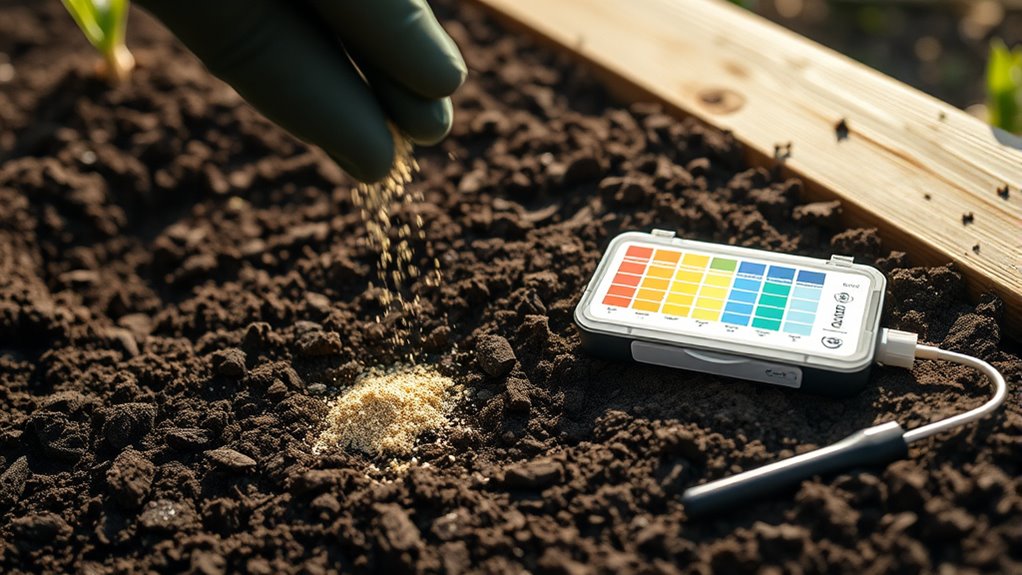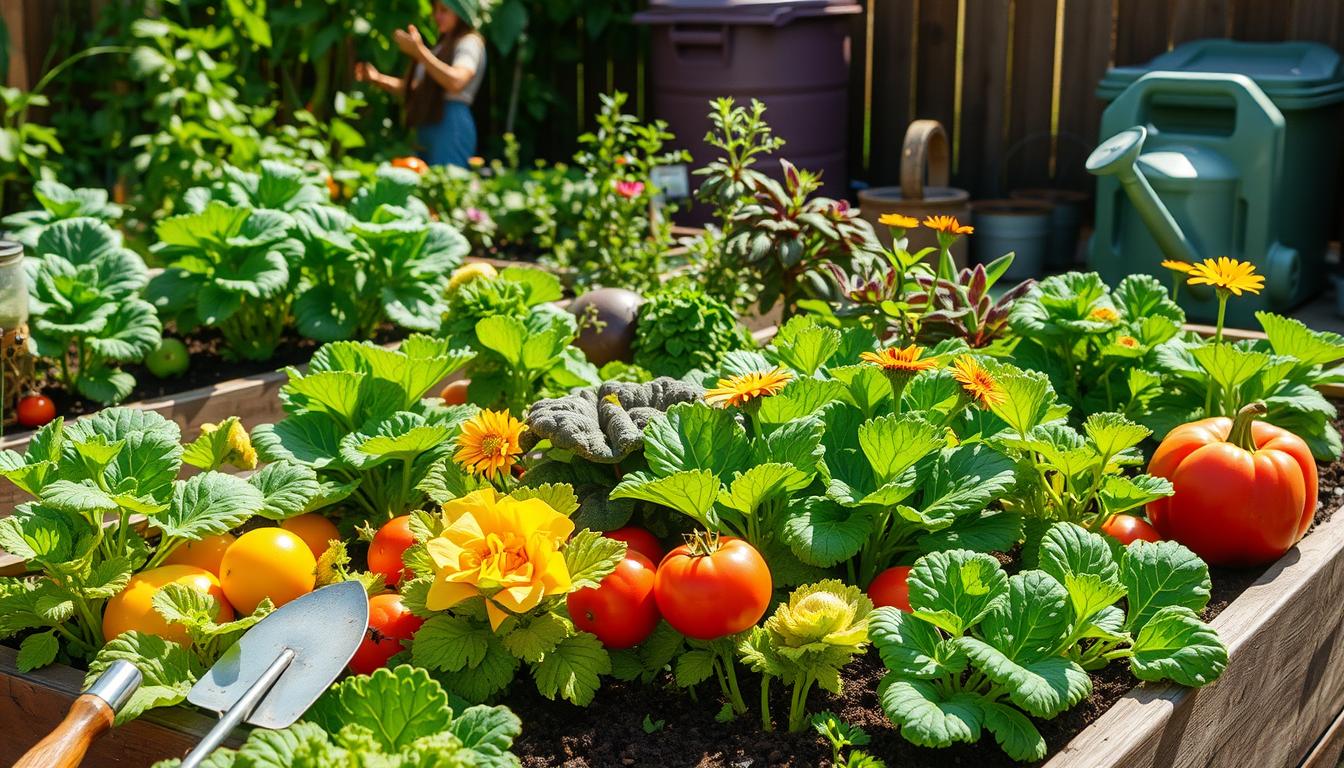To prepare your soil for winter, test it in the off-season, ideally in fall before the ground freezes, to assess nutrients and pH levels. Collect samples from various areas, keeping soil moist but not muddy, and analyze for nitrogen, phosphorus, and potassium. Based on results, choose appropriate fertilizers, like organic options or slow-release types, and apply them several weeks before heavy frost. Continue exploring for more tips to keep your soil healthy during cold months.
Key Takeaways
- Conduct soil tests in fall before ground freezes to assess nutrient levels and pH for effective winter fertilization planning.
- Collect soil samples from multiple yard areas when moist, avoiding debris, and analyze for nitrogen, phosphorus, potassium, and pH.
- Apply appropriate fertilizers—preferably organic or slow-release—4-6 weeks before the first hard freeze to prepare soil for winter.
- Incorporate compost or mulch to insulate soil, prevent erosion, and support soil health during the cold months.
- Use soil sensors and avoid excessive tillage to maintain soil structure, moisture, and nutrient balance through winter.
Why Soil Testing Matters in the Off-Season
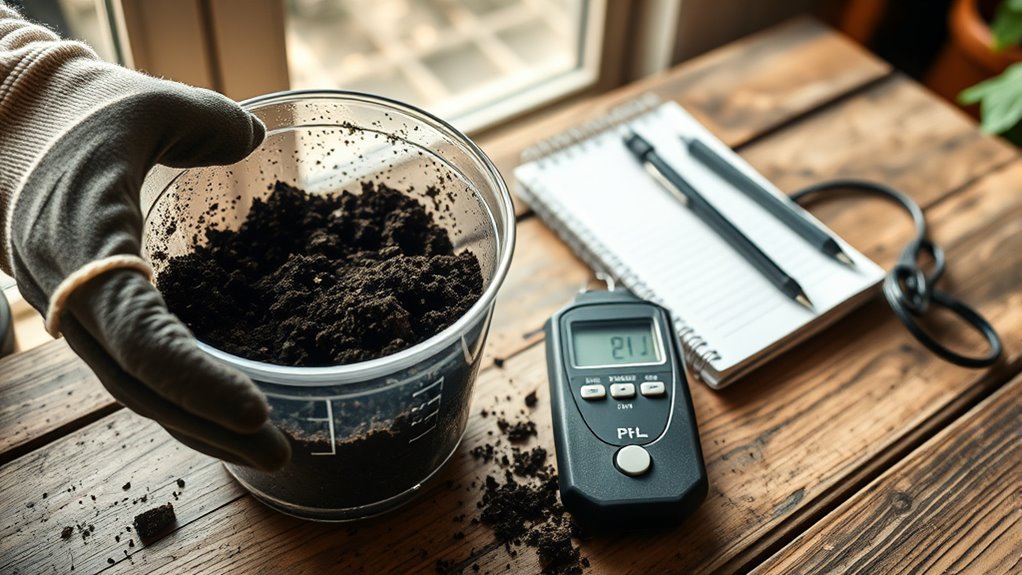
Performing soil tests during the off-season is essential because it gives you a clear understanding of your soil’s nutrient levels and pH balance before the growing season begins. Knowing these details helps you plan effective fertilization strategies, saving you time and money later. When you test in advance, you identify deficiencies or imbalances early, allowing you to amend the soil properly. This proactive approach promotes healthier plant growth, stronger roots, and better yields. Additionally, testing during the off-season prevents rushed decisions when planting time arrives. It’s an opportunity to analyze your soil without the pressure of an upcoming planting deadline. By understanding your soil’s condition now, you set the stage for a successful, productive growing season ahead. Incorporating proper soil testing methods ensures you obtain accurate results that guide your fertilization plan effectively.
How to Collect Soil Samples Effectively

To collect soil samples effectively, start by using proper sampling techniques, such as taking multiple samples from different areas of your yard. Timing is important, so test your soil when it’s moist but not muddy, and plan to sample at least once a year for accurate results. Regular sampling helps you understand your soil’s needs and guarantees your fertilizing efforts are targeted and effective. Incorporating soil testing can also identify nutrient deficiencies to optimize fertilization efficiency.
Proper Sampling Techniques
Collecting representative soil samples is crucial for accurate testing, so you need to follow proper techniques to guarantee reliable results. First, gather samples from multiple locations across your yard or garden to capture variability. Use a clean, sharp trowel or soil probe to collect soil from the top 6-8 inches, avoiding debris like roots or stones. Take small subsamples from each spot and combine them into a single, well-mixed sample. Avoid sampling near fertilizer, compost, or manure piles, as these can skew results. Label your sample clearly with the location and date. Place the composite sample into a clean container, such as a plastic bag or bucket, and keep it cool until you send it for testing. Proper sampling ensures you get an accurate picture of your soil’s nutrient levels. Incorporating soil testing kits can help you monitor your soil health more effectively and adjust your fertilizing strategy accordingly.
Timing and Frequency
Timing your soil samples correctly is essential to get accurate results, and sampling at the right times guarantees you’re making informed decisions about fertilizing and soil management. The best time to test is during the fall, before the ground freezes, when soil conditions reflect your current nutrient levels. Avoid sampling during or immediately after heavy rainfall, as this can dilute nutrients and skew results. Conduct tests every 2 to 3 years to track soil health and adjust fertilization plans accordingly. Early fall is ideal, as it allows you to address nutrient deficiencies before winter. Consistency in sampling seasonally helps you identify trends and make timely adjustments, ensuring your soil stays healthy and productive for the upcoming growing season. Additionally, understanding the nutrient levels in your soil helps optimize fertilization and improve crop yields.
Interpreting Soil Test Results for Optimal Fertilization

Understanding your soil test results is key to applying the right amount of fertilizer for winter. You’ll see levels of nutrients like nitrogen, phosphorus, and potassium, plus pH values. Low levels indicate a need for supplementation, while high levels suggest reduced application. Use the following table to interpret your results:
| Nutrient Level | Action Needed | Notes |
|---|---|---|
| Deficient | Apply fertilizer containing this nutrient | Corrects deficiencies for plant health |
| Optimal | No immediate action needed | Maintain existing levels |
| Excess | Reduce or skip application | Prevents nutrient runoff and damage |
| pH | Adjust soil pH if needed | Ensures nutrient availability |
Properly soil testing ensures that you apply the appropriate amount of fertilizer, preventing over-application and environmental harm.
Choosing the Right Fertilizers for Winter Application
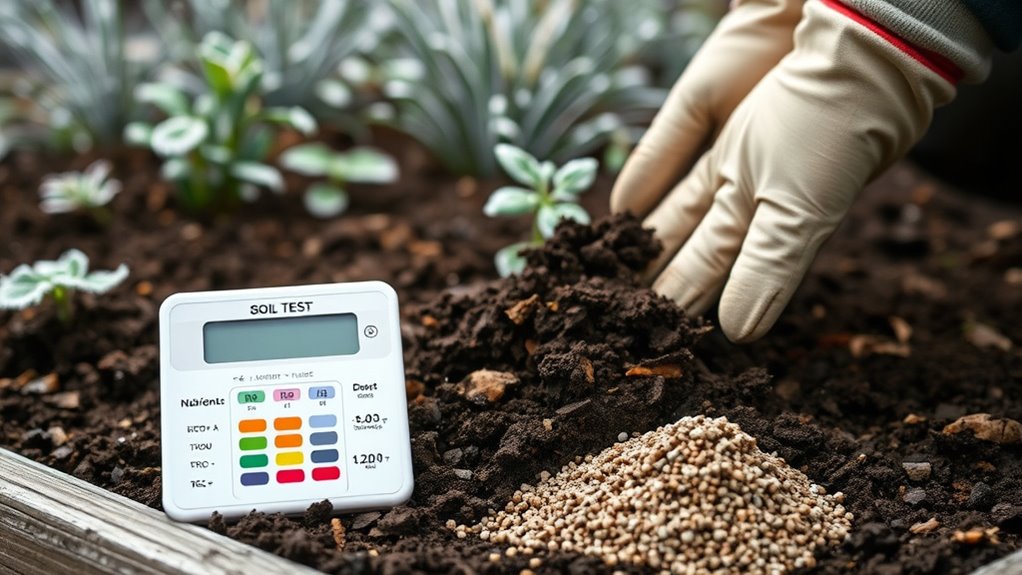
When selecting fertilizers for winter, you need to consider your soil’s nutrient needs and how different options meet those needs. Organic fertilizers release nutrients slowly and improve soil health, while synthetic ones provide quick results but may impact the environment. Understanding your specific soil test results helps you choose the most effective fertilizer type for winter application. Additionally, considering the father-daughter bond can remind gardeners of the nurturing relationship involved in caring for the soil and plants during colder months.
Nutrient Needs Specifics
Choosing the right fertilizers for winter application requires understanding your soil’s specific nutrient needs. After testing, you’ll identify which nutrients are deficient or abundant. Focus on the key nutrients: nitrogen, phosphorus, and potassium. Winter plants generally need less nitrogen, as excessive amounts can lead to leaching and runoff, but they still require enough to support root growth. Phosphorus promotes strong root development, so ensure your soil has adequate levels for healthy roots. Potassium helps plants withstand cold and stress; supplement if levels are low. Consider slow-release fertilizers to provide steady nutrients over winter, reducing leaching risks. Properly matching fertilizers to your soil’s needs guarantees healthy, resilient plants come spring. Recognizing Narcissistic tendencies in soil management might seem unusual, but understanding how different nutrients interact can prevent imbalances that hinder plant health.
Organic vs. Synthetic
Selecting the right fertilizer type for winter application depends on your soil’s needs and your gardening approach. Organic fertilizers, like compost, manure, or bone meal, release nutrients slowly and improve soil health over time. They’re ideal if you want sustainable, long-term benefits and prefer natural methods. Synthetic fertilizers, on the other hand, provide immediate nutrient availability, which can boost plant growth quickly. They’re useful if your soil needs rapid correction or specific nutrient boosts. However, synthetic options may lead to nutrient runoff and soil degradation if overused. Consider your soil test results and your goals—if you prioritize environmental health and soil fertility, organic fertilizers are the better choice. For quick fixes or specific nutrient deficiencies, synthetic fertilizers may serve you better. Additionally, incorporating vertical storage solutions can help organize your gardening supplies and keep your work area tidy during winter preparations.
Timing and Methods for Fertilizer Application Before Winter
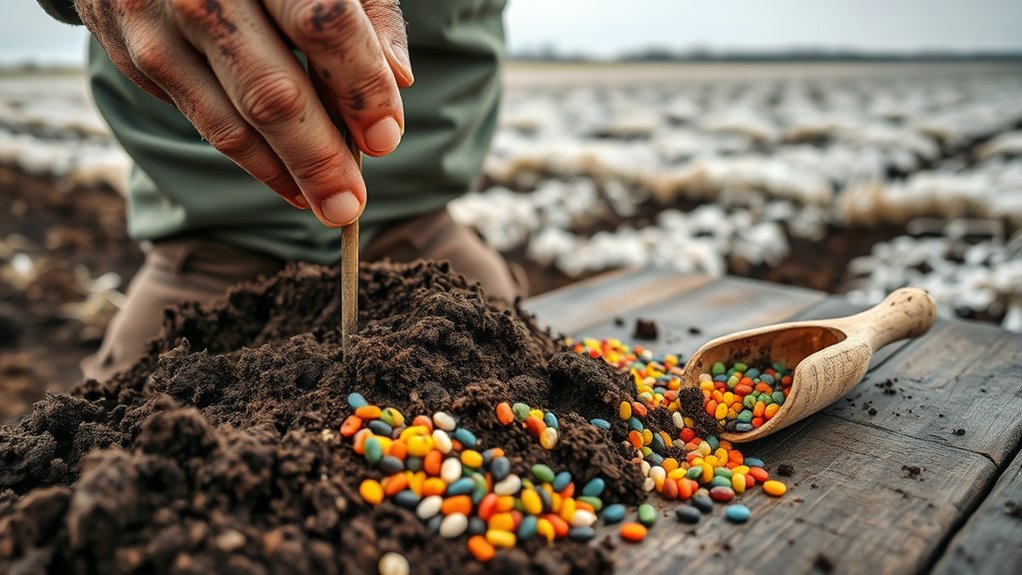
To make certain your soil is well-prepared for winter, it’s vital to apply fertilizer at the right time and using appropriate methods. Ideally, you should fertilize in late fall, about four to six weeks before the first hard freeze. This allows nutrients to penetrate deeply and be absorbed by plant roots. Use slow-release or organic fertilizers for a steady nutrient supply, minimizing leaching. Apply evenly across your soil, avoiding excess that could lead to runoff or damage. If you’re working with lawns, broadcast fertilizer evenly and lightly water it in. For garden beds, incorporate the fertilizer into the topsoil. Proper timing and careful application help guarantee your soil remains healthy and ready for winter dormancy, supporting vigorous growth in the spring. Understanding soil chemistry can further enhance your fertilization strategy for optimal results.
Tips for Maintaining Soil Health During Cold Months
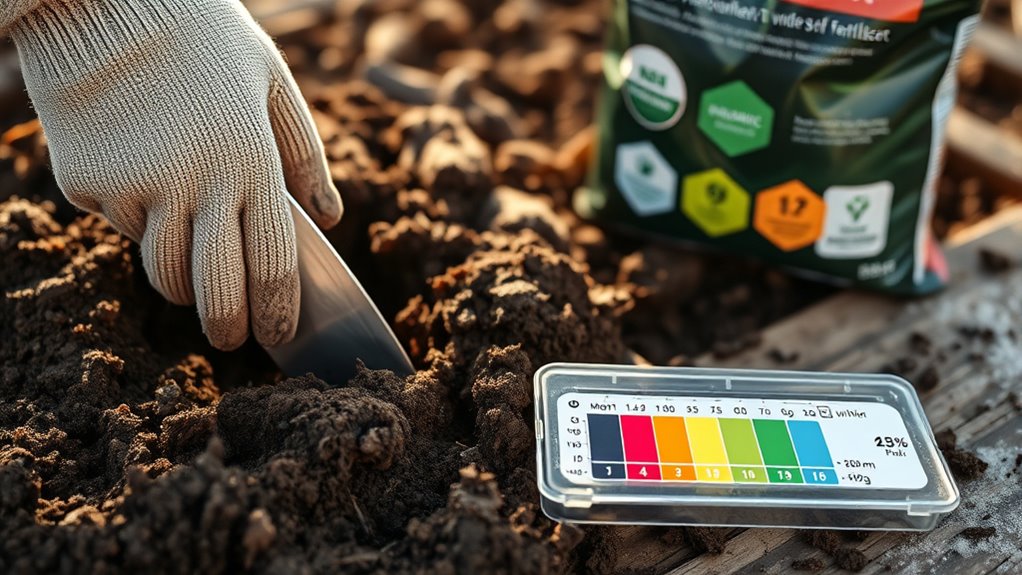
Maintaining soil health during cold months requires proactive strategies to protect its structure and nutrient content. First, apply a layer of compost or organic mulch to insulate the soil and prevent erosion. This helps retain moisture and moderates temperature fluctuations. Avoid disturbing the soil unnecessarily, as tilling can disrupt soil organisms and structure. Consider planting cover crops like clover or vetch, which add organic matter and fix nitrogen naturally. Keep soil moist but not waterlogged, since excessive moisture can lead to compaction or root rot. Additionally, avoid over-fertilizing late in the season; instead, focus on building organic matter now for healthier soil come spring. Incorporating soil sensors can help monitor moisture and nutrient levels more precisely. These steps help preserve soil vitality, ensuring it remains fertile and resilient throughout the winter months.
Frequently Asked Questions
When Is the Best Time to Conduct Soil Testing in Winter?
You should conduct soil testing in late fall or early winter, ideally when the soil is moist but not frozen. This timing allows you to gather accurate nutrient data before the ground fully freezes, giving you time to plan fertilization for spring. Avoid testing during deep winter, as cold temperatures can skew results. Testing during this window helps you optimize soil health and prepare for the upcoming growing season.
Can Soil Testing Detect Soil Pests or Diseases?
Yes, soil testing can detect certain pests and diseases, but it’s limited. You’ll primarily find out about nutrient levels, pH, and soil health. To identify pests or diseases, you need to visually inspect plants and soil for signs like discoloration, spots, or pests themselves. Combining soil testing with regular plant examination gives you a clearer picture of soil and plant health, helping you take targeted action.
How Often Should I Test My Soil During Winter?
You should test your soil once or twice during winter, especially if you notice changes in plant health or growth. Testing helps you monitor nutrient levels and detect any issues early. Keep in mind that winter testing is less common unless you’re growing winter crops or preparing for spring planting. Use a reliable soil test kit or hire a professional to get accurate results and plan your fertilizing schedule effectively.
Are There Specific Fertilizers Recommended for Winter Use?
Yes, you should use a slow-release fertilizer or a winter-specific formula, like a low-nitrogen blend, to support your plants during colder months. These fertilizers release nutrients gradually, reducing runoff and promoting healthy root growth. Apply them before the first heavy frost, ensuring your soil stays nourished throughout winter. Always follow the manufacturer’s instructions to avoid over-fertilizing, which can harm your plants.
How Can I Prevent Nutrient Runoff During Winter Fertilization?
You can prevent nutrient runoff during winter fertilization by applying fertilizer carefully, avoiding excessive amounts, and using slow-release formulas. Make sure to fertilize when the soil is moist but not saturated, and avoid fertilizing before heavy rains or snowmelt. Incorporate fertilizers into the soil gently, and consider using organic options that bind nutrients more effectively. Regularly monitor weather forecasts to time your applications wisely.
Conclusion
Don’t skip soil testing before winter — it guarantees you use the right fertilizers and avoid wasting money. Even if you’re worried about the cold, applying the right nutrients now helps your soil stay healthy and ready for spring planting. Plus, proper fertilizing can prevent nutrient runoff and environmental harm. So, take a little time now; your garden will thank you when it blooms again, and you’ll enjoy healthier, more vibrant plants come spring.

